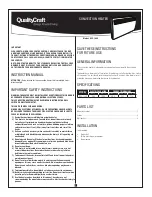
Page 10
R−Condenser Fan with
Variable Speed Motor(B4)
(−038 only)
The variable speed condenser fan motor (figure 14) used in all
HPXA19−038 units is a three-phase, electronically controlled
d.c. brushless motor (controller converts single phase a.c. to
three phase d.c.), with a permanent-magnet-type rotor,
manufactured by GE. Because this motor has a permanent
magnet rotor it does not need brushes like conventional D.C.
motors. The motors consist of a control module and motor .
Internal components are shown in figure 15. The stator wind-
ings are split into three poles which are electrically connected
to the controller. This arrangement allows motor windings to be
turned on and off in sequence by the controller.
The controller is primarily an a.c. to d.c. converter. Con-
verted d.c. power is used to drive the motor. The control-
ler contains a microprocessor which monitors varying
conditions inside the motor (such as motor workload).
The controller uses sensing devices to know what position
the rotor is in at any given time. By sensing the position of
the rotor and then switching the motor windings on and off
in sequence, the rotor shaft turns the blower.
VARIABLE SPEED CONDENSER FAN MOTOR
FIGURE 14
RED
YELLOW
BLACK
RED
BLUE
motor
control module
BLOWER MOTOR COMPONENTS
FIGURE 15
STATOR
(WINDINGS)
OUTPUT
SHAFT
BEARING
ROTOR
Internal Operation
The condenser fan motor is a variable speed motor with RPM
settings at 700 (Y1) and 820 (Y2). The variation in speed is
accomplished each time the controller switches a stator wind-
ing (figure14) on and off, it is called a pulse." The length of
time each pulse stays on is called the pulse width." By vary-
ing the pulse width the controller varies motor speed (called
pulse-width modulation"). This allows for precise control of
motor speed and allows the motor to compensate for varying
load conditions as sensed by the controller. In this case, the
controller monitors the static workload on the motor and var-
ies motor rpm in order to maintain constant airflow (cfm).
Motor rpm is continually adjusted internally to maintain
constant static pressure against the fan blade. The control-
ler monitors the static work load on the motor and motor
amp-draw to determine the amount of rpm adjustment.
Blower rpm is adjusted internally to maintain a constant
cfm. The amount of adjustment is determined by the incre-
mental taps which are used and the amount of motor load-
ing sensed internally. The motor constantly adjusts rpm to
maintain a specified cfm.
Initial Power Up
When line voltage is applied to the motor, there will be a
large inrush of power lasting less than 1/4 second. This in-
rush charges a bank of DC filter capacitors inside the con-
troller. If the disconnect switch is bounced when the discon-
nect is closed, the disconnect contacts may become
welded. Try not to bounce the disconnect switch when ap-
plying power to the unit.
The DC filter capacitors inside the controller are connected
electrically to the speed tap wires. The capacitors take
approximately 5 minutes to discharge when the disconnect
is opened. For this reason it is necessary to wait at least 5
minutes after turning off power to the unit before attempting
to service motor.
DANGER
Disconnect power from unit and wait at
least five minutes to allow capacitors
to discharge before attempting to ser-
vice motor. Failure to wait may cause
personal injury or death.
Motor Start-Up
At start-up, the motor may gently rock back and forth for a
moment. This is normal. During this time the electronic
controller is determining the exact position of the rotor.
Once the motor begins turning, the controller slowly
eases the motor up to speed (this is called soft-start").
The motor may take as long as 10-15 seconds to reach
full speed. If the motor does not reach 200rpm within 13
seconds, the motor shuts down. Then the motor will im-
mediately attempt a restart. The shutdown feature pro-
vides protection in case of a frozen bearing or blocked
fan blade. The motor may attempt to start eight times. If
the motor does not start after the eighth try, the controller
locks out. Reset controller by momentarily turning off
power to unit.











































